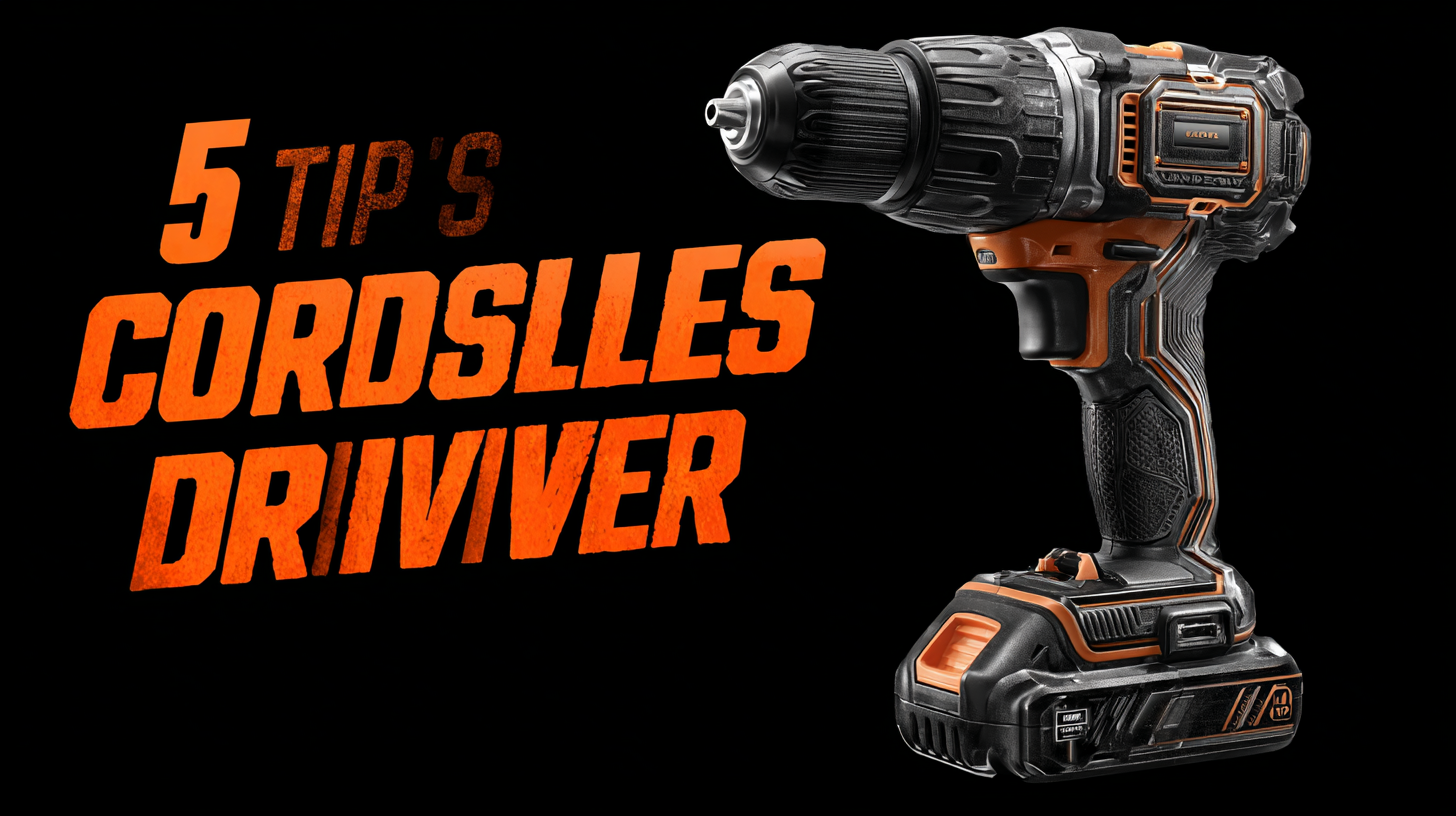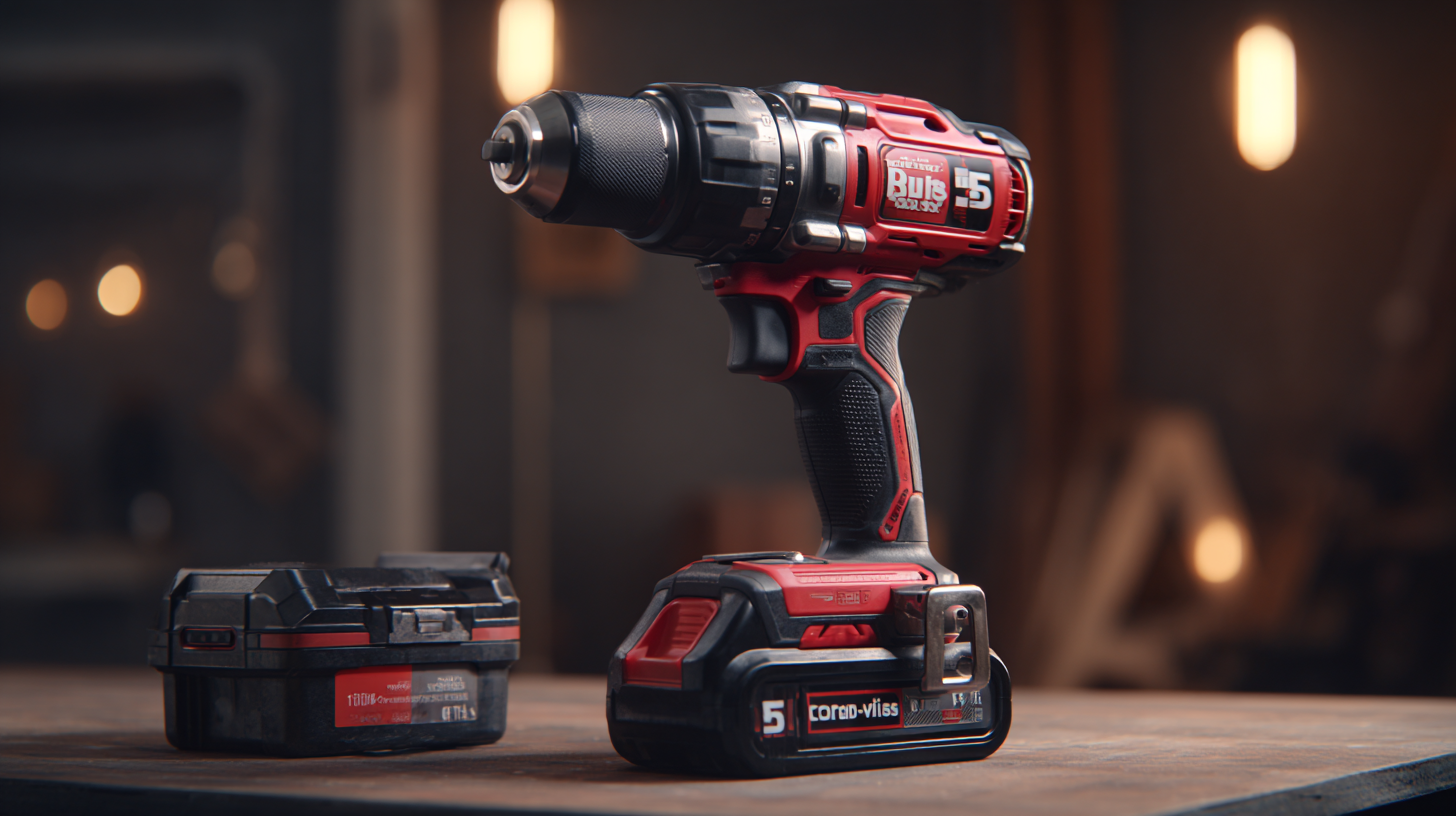5 Essential Tips for Choosing the Best Cordless Driver: Maximize Efficiency in Your Projects
In the rapidly evolving world of power tools, the cordless driver has emerged as a crucial instrument for both professionals and DIY enthusiasts alike. Recent industry reports indicate that the global power tools market is projected to reach $41.2 billion by 2026, with the cordless tools segment witnessing a substantial growth rate of over 6% annually. This surge can be attributed to the increasing demand for portability, convenience, and versatility in construction and home improvement projects. As manufacturers continue to elevate quality standards—signified by the phrase "Made in China, Quality Upgrade, Best-Selling Worldwide"—selecting the right cordless driver becomes essential for maximizing efficiency and achieving superior results.
In this blog, we will explore five essential tips to help you choose the best cordless driver tailored to your specific needs, ensuring that your projects are executed with precision and ease.
Key Features to Look for in a Cordless Driver for Optimal Performance
When selecting a cordless driver, understanding key features is essential to maximize efficiency and performance in your projects. First, consider the power and voltage; higher voltage tools generally provide better performance and longevity for demanding tasks. According to industry data, a 20V cordless driver can deliver up to 30% more torque than a 12V model, making it a crucial factor for serious home improvement enthusiasts and professionals alike.
Another important aspect is battery life and type. Lithium-ion batteries are favored for their lightweight and long-lasting characteristics. Studies have shown that tools equipped with lithium-ion batteries maintain performance levels for longer periods, reducing downtime. Moreover, look for features such as adjustable torque settings, which allow for better control in various applications; those with a wide range of settings can improve precision and results, making them indispensable in the toolkit of any skilled worker.
Finally, weight and ergonomics also play a significant role in optimal performance. Tools that are lighter and designed with user comfort in mind reduce fatigue during prolonged use, leading to increased productivity. According to a survey, 65% of users reported enhanced productivity when using ergonomically designed tools compared to standard models. Therefore, considering these essential features when choosing a cordless driver can greatly enhance project outcomes and user satisfaction.

Understanding Battery Technology: Impact on Efficiency and Longevity
When selecting the best cordless driver, one of the most critical factors to consider is battery technology. The type of battery not only influences the efficiency of the tool but also affects its longevity and overall performance. Currently, lithium-ion batteries are the standard choice, offering a remarkable energy-to-weight ratio and faster charging times compared to older nickel-cadmium versions. These batteries maintain consistent power levels, which is essential for tasks requiring precision, ensuring that the driver performs optimally until the last charge.
Additionally, understanding the impact of watt-hours (Wh) is crucial when evaluating battery capacity. A higher Wh rating typically translates to a longer run time, allowing you to complete projects without frequent interruptions for recharging. However, it's not just about capacity; consider the battery management system integrated into the cordless driver. Advanced systems monitor temperature and charge cycles, significantly enhancing the battery's lifespan and reliability. Therefore, investing in a cordless driver with an efficient battery technology ensures that your tools will not only maximize your productivity but also provide consistent performance over time.
Battery Efficiency Comparison Among Cordless Drivers
This chart compares the average runtime and charging time of different types of battery technologies used in cordless drivers. Lithium-ion batteries, being the most common, typically offer a longer runtime and shorter charging time compared to Nickel-Cadmium and Nickel-Metal Hydride batteries.
Torque Ratings Explained: Choosing the Right Power for Your Tasks
When selecting the best cordless driver for your projects, understanding torque ratings is crucial. Torque, measured in inch-pounds or Newton-meters, refers to the rotational force that the driver can apply. Higher torque ratings indicate a more powerful tool capable of driving larger screws or drilling into tougher materials. For light-duty tasks, such as assembling furniture or installing shelves, a driver with a torque rating of around 200 inch-pounds may suffice. However, for heavier applications, like working with dense hardwood or fastening larger bolts, a tool with a torque rating of 300 inch-pounds or more is advisable.
It's also essential to consider the adjustable settings on a cordless driver. Many models offer various torque settings, allowing you to tailor the power output to the specific material you're working with. This feature is invaluable for preventing overdriving or stripping screws, which can lead to project delays and frustrations. By assessing the torque requirements of your tasks and selecting a driver that matches these needs, you can enhance your efficiency and achieve optimal results in your work.
5 Essential Tips for Choosing the Best Cordless Driver
| Feature |
Description |
Recommended Range |
| Torque Rating |
Measure of rotational force available |
30-80 Nm for standard tasks |
| Battery Voltage |
Impacts power output and tool weight |
18V for most users; 12V for light-duty |
| Chuck Size |
Determines the size of the drill bits |
1/2 inch for versatility |
| Speed Settings |
Enables control over drilling speed |
Variable speeds up to 2000 RPM |
| Weight |
Impacts ease of use during prolonged tasks |
Under 5 lbs for optimal handling |
Lightweight vs. Heavy-Duty: Selecting the Best Build for Your Projects
When selecting the best cordless driver for your projects, choosing between a
lightweight and
heavy-duty build is crucial for maximizing efficiency.
Lightweight cordless drivers are ideal for smaller projects
or when you need to work overhead. These tools offer reduced fatigue, making it easier to handle them for extended periods.
A lightweight driver is especially beneficial for tasks like assembling furniture or installing cabinetry,
where precision and maneuverability are key.
On the other hand,
heavy-duty cordless drivers are designed for more intense applications,
such as drilling into tough materials or tackling larger construction tasks. These models usually come with more powerful motors
and a robust build, ensuring that they can withstand rigorous use. When selecting a heavy-duty option, consider the
battery life and
torque specifications, as these will significantly impact performance on demanding jobs.
An essential tip when choosing between the two is to assess the nature of your projects. If
versatility is your goal, opting for a cordless driver that offers
a balance between weight and power may be the best approach. Look for features like adjustable torque settings and
quick-charging batteries to enhance your workflow, regardless of the driver type you choose.
Top Brands in Cordless Drivers: How Manufacturing Quality Matters
When selecting a cordless driver, the importance of manufacturing quality cannot be overstated. Renowned brands in the power tool industry invest significantly in their production processes to ensure durability and performance. According to a report by MarketWatch, the global power tools market is expected to reach $37.8 billion by 2027, demonstrating a growing emphasis on reliable and efficient tools. Leading manufacturers like DeWalt and Makita have become household names by consistently delivering products that meet rigorous safety and performance standards. Their commitment to quality craftsmanship is what sets them apart in a competitive marketplace.

Additionally, innovations in battery technology are reshaping the cordless driver landscape. As per a study by Research and Markets, lithium-ion batteries dominate the market, accounting for over 70% of total power tool battery sales in 2022. Brands that prioritize the use of advanced battery technology in their cordless drivers not only enhance user convenience but also prolong the lifespan of the tool. This focus on manufacturing excellence reflects a broader trend toward efficiency, as contractors and DIY enthusiasts alike seek out tools that can withstand the rigors of extensive use while offering superior performance.
 English
English English
English Español
Español Português
Português русский
русский Français
Français 日本語
日本語 Deutsch
Deutsch tiếng Việt
tiếng Việt Italiano
Italiano Nederlands
Nederlands ภาษาไทย
ภาษาไทย Polski
Polski 한국어
한국어 Svenska
Svenska magyar
magyar Malay
Malay বাংলা ভাষার
বাংলা ভাষার Dansk
Dansk Suomi
Suomi हिन्दी
हिन्दी Pilipino
Pilipino Türkçe
Türkçe Gaeilge
Gaeilge العربية
العربية Indonesia
Indonesia Norsk
Norsk تمل
تمل český
český ελληνικά
ελληνικά український
український Javanese
Javanese فارسی
فارسی தமிழ்
தமிழ் తెలుగు
తెలుగు नेपाली
नेपाली Burmese
Burmese български
български ລາວ
ລາວ Latine
Latine Қазақша
Қазақша Euskal
Euskal Azərbaycan
Azərbaycan Slovenský jazyk
Slovenský jazyk Македонски
Македонски Lietuvos
Lietuvos Eesti Keel
Eesti Keel Română
Română Slovenski
Slovenski मराठी
मराठी Srpski језик
Srpski језик



